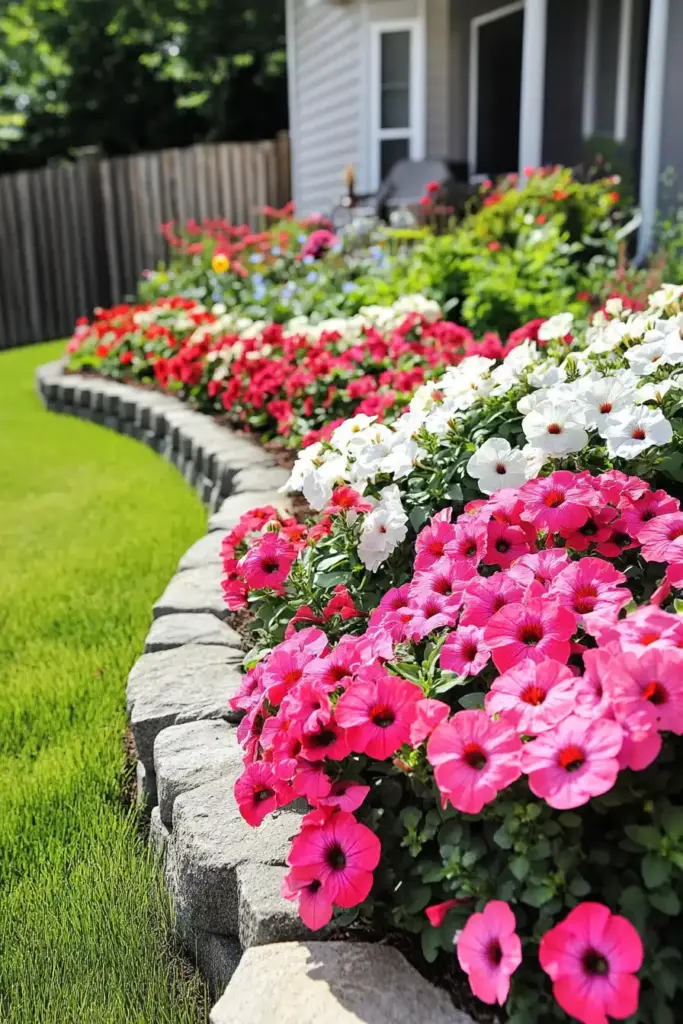Looking for fresh flower bed ideas that combine charm, color, and easy maintenance? Begonias might be exactly what your garden needs. These vibrant, shade-tolerant blooms are celebrated for their versatility and range of hues—from delicate pastels to bold reds and fiery oranges. Whether you’re enhancing a small garden space or revamping your flower beds in the front yard, begonias bring structure and visual impact to nearly any garden setting. They’re perfect for patios, containers, and especially shaded corners where other plants might struggle.
In this guide, you’ll explore 17+ stunning flower bed ideas using begonias to illuminate everything from raised beds to woodland-inspired borders. With expert design tips on layering, edging, and smart plant pairings, you’ll gain plenty of inspiration to transform your outdoor space into a blooming, low-maintenance oasis. Plus, if you’re planning to brighten your lawn edges, don’t miss our creative front yard landscaping ideas for more ways to frame your begonias beautifully.
Table of Contents
1. Curved Begonia Beds: Add Flow and Elegance to Your Garden
When it comes to flower bed ideas, few options are as visually captivating as curved designs filled with vibrant begonias. Curved beds soften harsh garden lines and guide the eye naturally through your landscape, creating a sense of movement and calm. Begonias—with their compact growth and bold colors—accentuate these shapes beautifully.
Why It Works:
- Natural Aesthetic: The gentle arc of a curved bed mimics forms found in nature, offering a more organic feel.
- Visual Movement: Curves encourage exploration and invite you deeper into the garden.
- Perfect for Borders: Use along paths, patios, or as a standalone feature in a lawn.
Design Tips:
- Edging Stones: Define your curves with durable landscape stones or brick borders.
- Solar Path Lights: Add ambiance in the evening while highlighting your bed’s elegant shape.
- Organic Flower Fertilizer: Promote healthy begonia blooms with nutrient-rich soil amendments.
Bonus Tip:
Choose begonia varieties like Dragon Wing or Wax Begonias that offer bushy, continuous blooms to keep your curved beds looking lush throughout the season.
2. Raised Beds for Easy Care: Structure Meets Simplicity
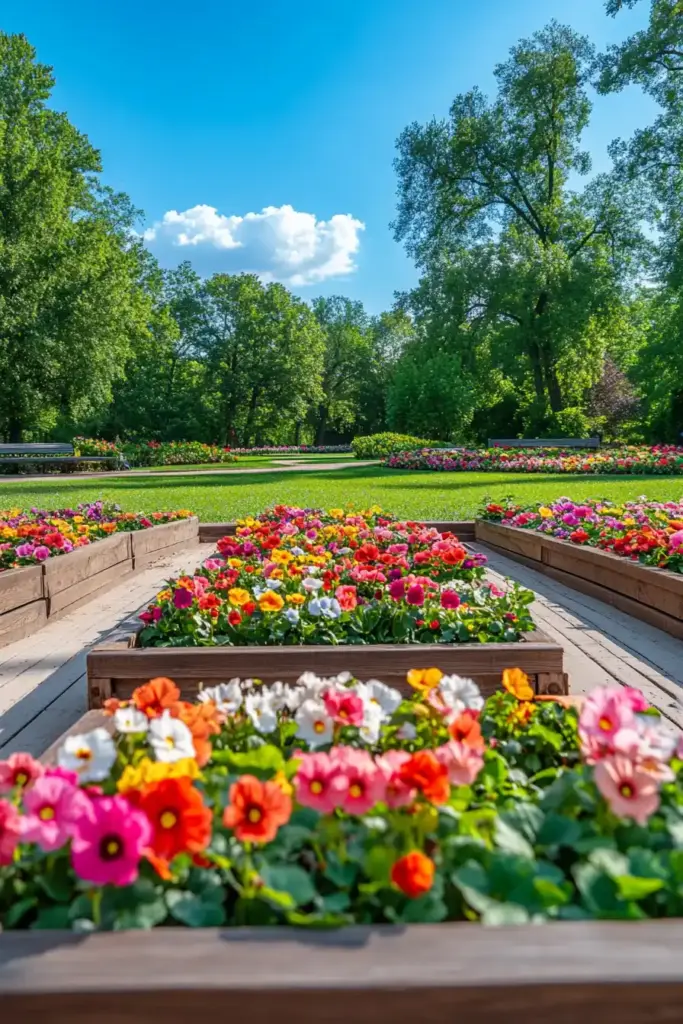
Looking for flower bed ideas that make gardening more manageable without sacrificing style? Raised beds filled with begonias offer the perfect balance. They provide excellent drainage, reduce bending and kneeling, and give your garden a clean, organized look. For beginners and seasoned gardeners alike, raised beds are a smart, functional choice.
Why It Works:
- Improved Drainage: Begonias thrive in well-drained soil—raised beds help prevent root rot.
- Better Accessibility: Great for gardeners with limited mobility or small spaces.
- Defined Aesthetics: Adds neat lines and visual height variation to your garden.
Design Tips:
- Raised Bed Kits: Opt for wooden or composite kits that are easy to assemble and weather-resistant.
- Flower Bed Soil Mix: Fill with nutrient-rich garden soil tailored to flowering plants.
- Drip Irrigation Systems: Keep watering efficient and consistent, especially in sunny or dry zones.
Bonus Tip:
Use your raised bed layout to group begonias by bloom color or height. This makes maintenance easier and gives a designer touch to your space.
3. Formal Meets Informal: Bridging Garden Styles with Begonias
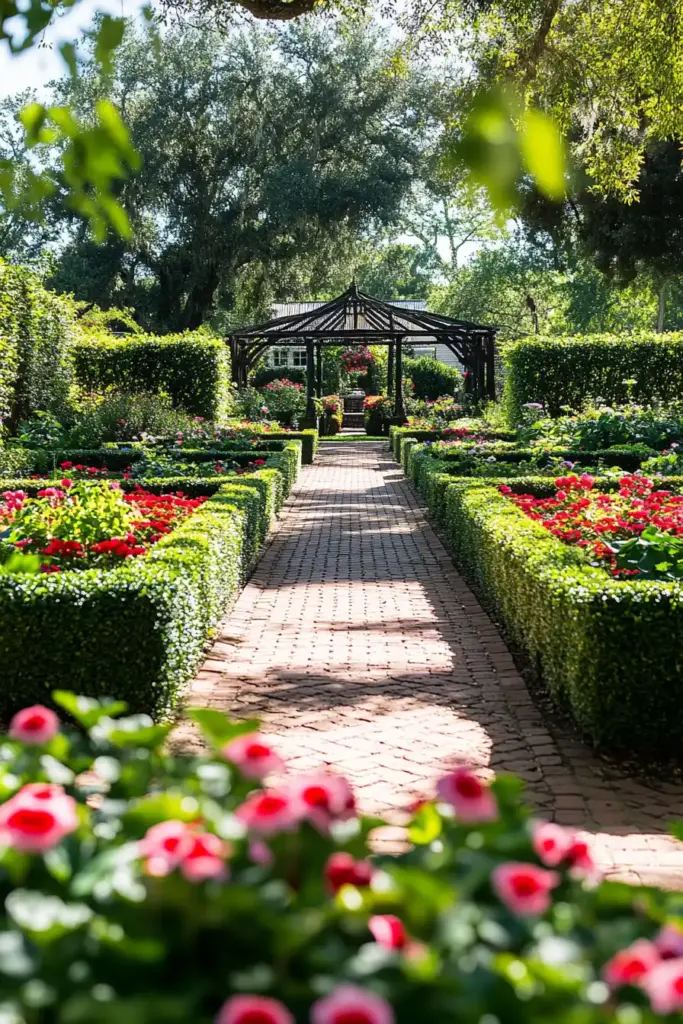
If you’re drawn to both clean structure and wild charm, this is one of the most versatile flower bed ideas to try. By using begonias to blend formal garden elements—like crisp borders or trimmed hedges—with more relaxed, free-form plantings, you can create a space that feels both elegant and approachable.
Why It Works:
- Balanced Design: Soft begonia blooms soften the rigidity of formal structures.
- Versatile Placement: Perfect for transition zones between patios and natural areas.
- Color Control: Begonias allow for planned color coordination or spontaneous blends.
Design Tips:
- Garden Edging: Use stone or metal edging to separate formal sections without harsh lines.
- Mixed Begonia Varieties: Combine upright and trailing types for depth and texture.
- Solar Lighting: Add subtle pathway or border lights to highlight form and color in the evening.
Bonus Tip:
Use symmetrical bed layouts filled with informal begonia groupings to create a “controlled chaos” look that feels timeless yet modern.
4. Beneath Trees and Shrubs: Layered Beauty with Shade-Loving Begonias
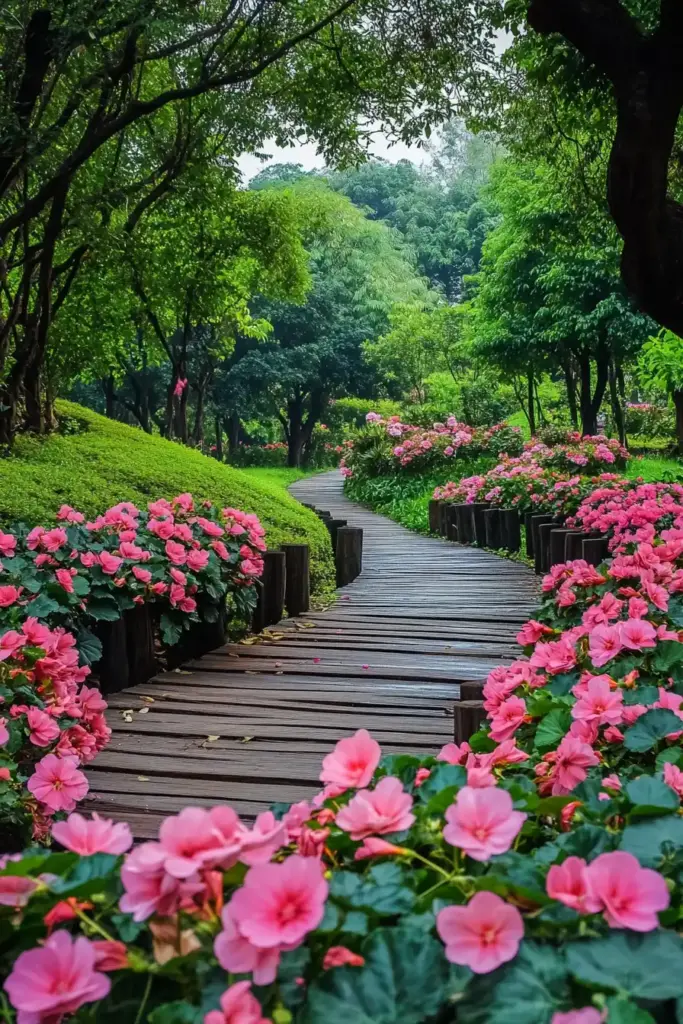
Don’t let the shaded spots under trees and large shrubs go to waste—these areas are ideal for shade-tolerant begonias. As one of the most adaptable plants for low-light conditions, begonias thrive beneath a leafy canopy, offering vibrant flower bed ideas that add depth and texture to layered garden designs.
Why It Works:
- Shade Compatibility: Begonias love partial shade and perform well under trees.
- Natural Layering: Adds visual interest and mimics woodland-style gardens.
- Moisture Retention: Tree cover reduces evaporation, creating a microclimate for moisture-loving plants.
Design Tips:
- Mulch Beds: Apply a thick layer of mulch to retain soil moisture and suppress weeds.
- Border Edging: Define the edge between grass and bed with stone, wood, or recycled rubber edging.
- Adjustable Sprinklers: Install sprinklers that gently water low-height plants without drenching overhead foliage.
Bonus Tip:
Choose begonias with contrasting foliage, like Rex or Angel Wing varieties, to stand out beneath the dappled light of trees and large shrubs.
5. Begonias for Shaded Corners: Brighten Up the Forgotten Spaces

Every garden has those shadowy corners—often overlooked, yet full of potential. If you’re looking for flower bed ideas to bring life to these dim spaces, begonias are your secret weapon. Their ability to flourish in low light makes them perfect for revitalizing areas where most blooms struggle.
Why It Works:
- Shade Resilience: Begonias adapt beautifully to areas with minimal sunlight.
- Instant Color Pop: Their bright, dense flowers make dull corners feel alive.
- Space Efficiency: Ideal for small nooks, tight borders, and narrow plots.
Design Tips:
- Moisture Control Potting Mix: Use specially formulated soil to help manage water retention in low-light zones.
- Decorative Edging: Elevate curb appeal with visually appealing garden borders that frame the begonia bed.
- Vertical Elements: Consider hanging baskets or stacked planters to build height and interest in limited space.
Bonus Tip:
Pair begonias with other shade-loving plants like ferns or caladiums for a textured, vibrant display that keeps shaded corners visually dynamic.
6. Colorful Patterns with Begonias: Design Garden Art with Blooms
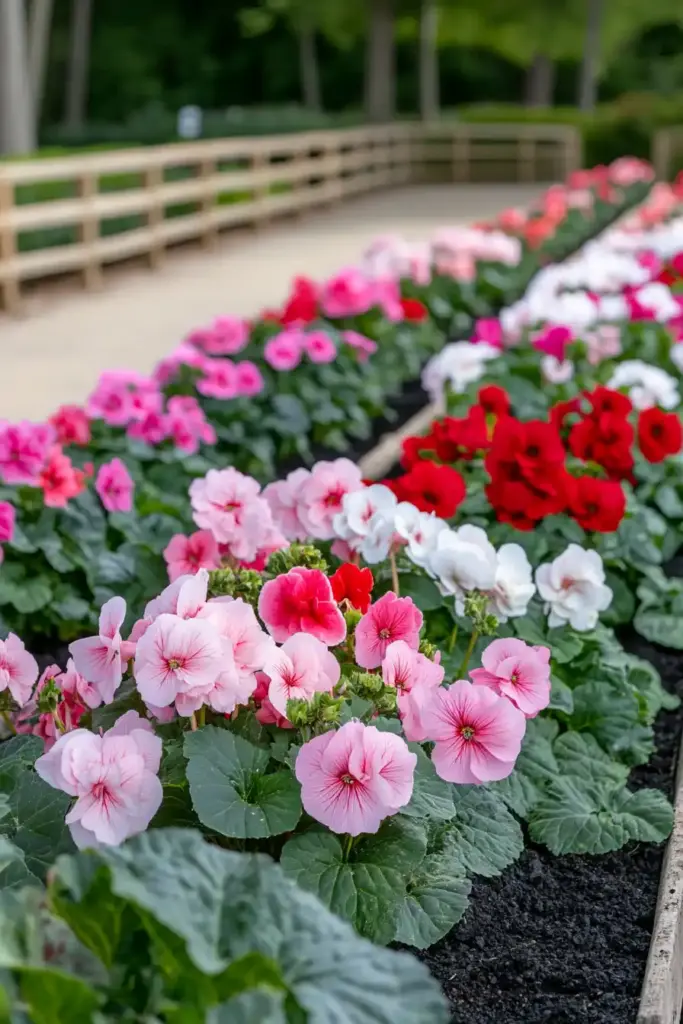
If you love making bold visual statements, creating flower bed ideas with patterned designs using begonias is a fun and artistic option. With their rich variety of colors and compact growth habits, begonias are ideal for forming floral mosaics, geometric shapes, or color-blocked beds that look like living artwork.
Why It Works:
- Vibrant Color Range: Use different begonia varieties to craft intricate color contrasts.
- Compact Growth: Keeps patterns neat and defined over time.
- High Visual Impact: Perfect for focal points in front yards or central beds.
Design Tips:
- Pre-Plan Your Layout: Sketch or use garden design software to map out your patterns.
- Spacing Matters: Keep consistent spacing between plants to maintain crisp shapes.
- Soil Enrichment: Use flower-specific soil mixes to enhance bloom vibrancy and growth uniformity.
Bonus Tip:
Incorporate symmetrical or repeating designs—like chevrons, waves, or checkerboards—for a polished effect. Stick to three color tones for cohesion, or go all-in with a rainbow burst!
7. Begonias as Ground Cover: A Living Carpet of Color
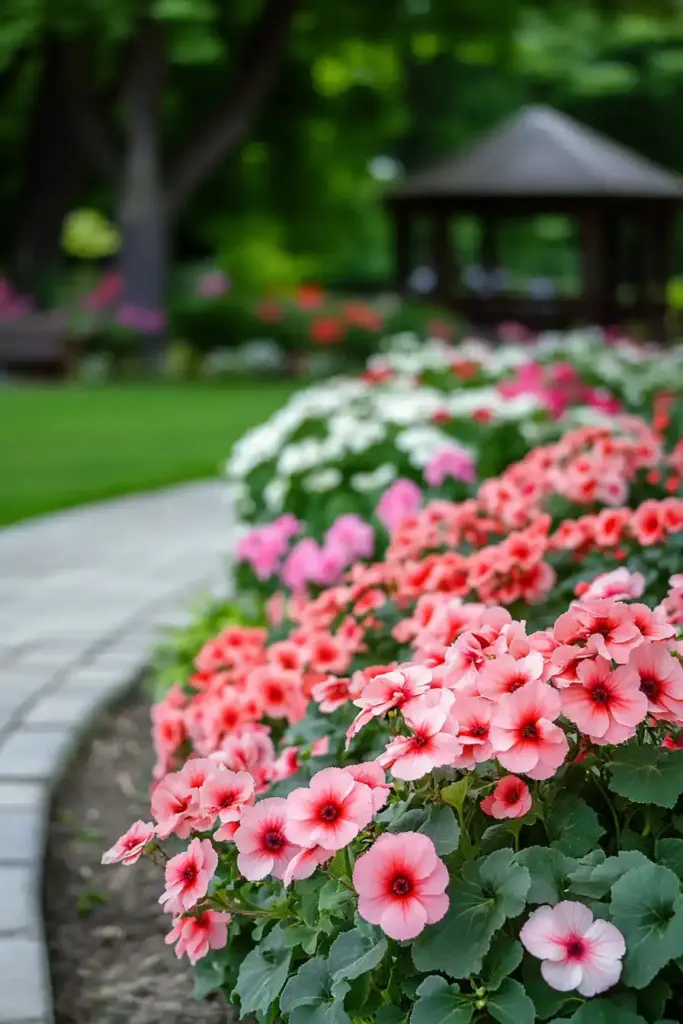
For gardeners seeking lush, low-growing flower bed ideas, using begonias as ground cover is a brilliant solution. Their dense foliage and long-lasting blooms form a vibrant living carpet that suppresses weeds and adds continuous interest through the seasons.
Why It Works:
- Dense Growth Habit: Begonias spread well to fill gaps, reducing the need for mulch or weed control.
- Long Blooming Season: Many begonias flower from spring to frost, keeping your garden colorful longer.
- Low Maintenance: Once established, ground-cover begonias require minimal care.
Design Tips:
- Bulb Layering: Plant spring bulbs like tulips or daffodils underneath to create a multi-season display.
- Edging Essentials: Use scalloped borders or natural stone to frame the begonia blanket neatly.
- Fertilize Regularly: A monthly application of organic fertilizer keeps the coverage lush and healthy.
Bonus Tip:
Try trailing or cascading begonia types along slopes or raised edges for a waterfall effect. It’s an easy way to add dimension and soften hard landscaping elements.
8. Mix and Match with Hostas: Foliage Harmony in Shaded Gardens

Combining begonias with hostas is one of the most classic and texturally rich flower bed ideas for shaded or woodland gardens. The bold foliage of hostas contrasts beautifully with the delicate blooms and fine leaves of begonias, creating a dynamic and lush landscape.
Why It Works:
- Contrast in Texture: Begonias’ fine leaves and bright flowers pop against the broad, textured foliage of hostas.
- Shared Preferences: Both plants thrive in partial to full shade and appreciate moist, well-draining soil.
- Season-Long Appeal: While begonias add seasonal color, hostas provide consistent foliage structure from spring through fall.
Design Tips:
- Group Strategically: Plant begonias in the foreground and medium-height hostas behind for a tiered effect.
- Color Coordination: Use green hostas to spotlight bright begonia blooms, or variegated varieties for extra flair.
- Enriched Soil Mix: Choose a balanced flower bed soil blend that supports both flowering and leafy perennials.
Bonus Tip:
Add a garden bench or stone path through this combo to create a shaded retreat that’s both restful and full of natural beauty.
9. Seasonal Begonia Displays: Color Through Every Season
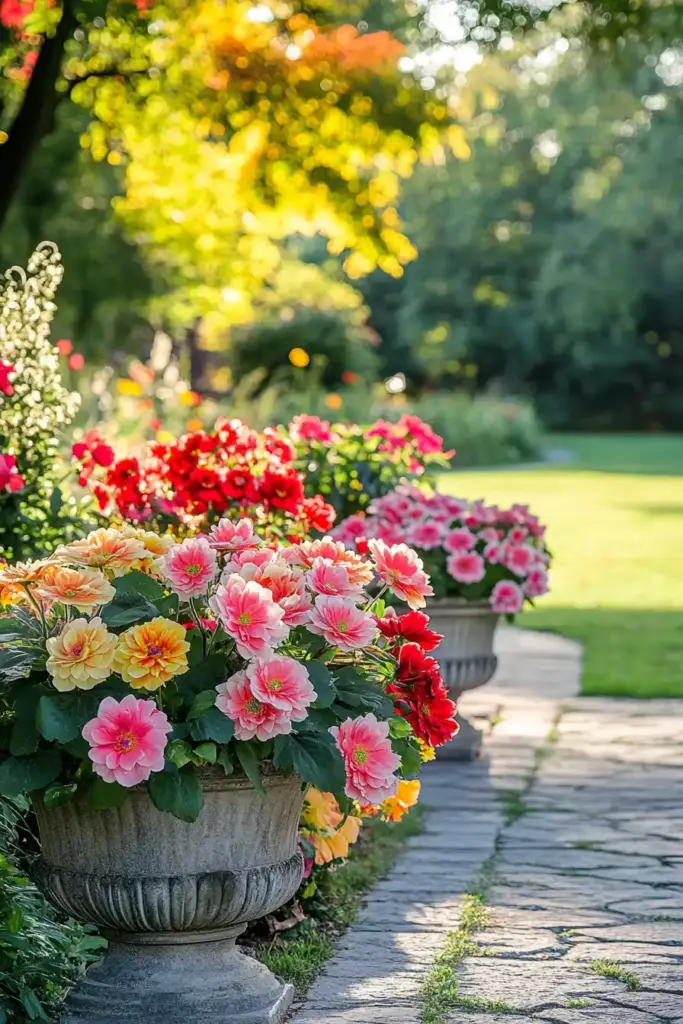
For gardeners who love to refresh their outdoor space throughout the year, seasonal displays with begonias are one of the most flexible flower bed ideas available. By rotating begonia varieties or changing containers and accents by season, you can enjoy continuous bursts of color from early spring to late fall.
Why It Works:
- Adaptability: Begonias perform well in both in-ground beds and portable containers.
- Seasonal Flexibility: Easy to swap out companion plants or reposition displays based on seasonal light changes.
- Year-Round Curb Appeal: Maintains interest even as other parts of the garden go dormant.
Design Tips:
- Use Decorative Urns or Planters: Position near entrances or patio corners for high-impact seasonal focal points.
- Coordinate with Annuals: Mix begonias with other seasonal flowers like pansies in spring or ornamental kale in fall.
- Lighting Matters: Add solar or LED pathway lighting to showcase evening beauty in every season.
Bonus Tip:
Change your soil mix with each season to match your begonia’s specific needs—lighter, fast-draining mixes in summer and more moisture-retentive ones in spring and fall.
10. Begonias in Rock Gardens: Soft Color Meets Hard Texture
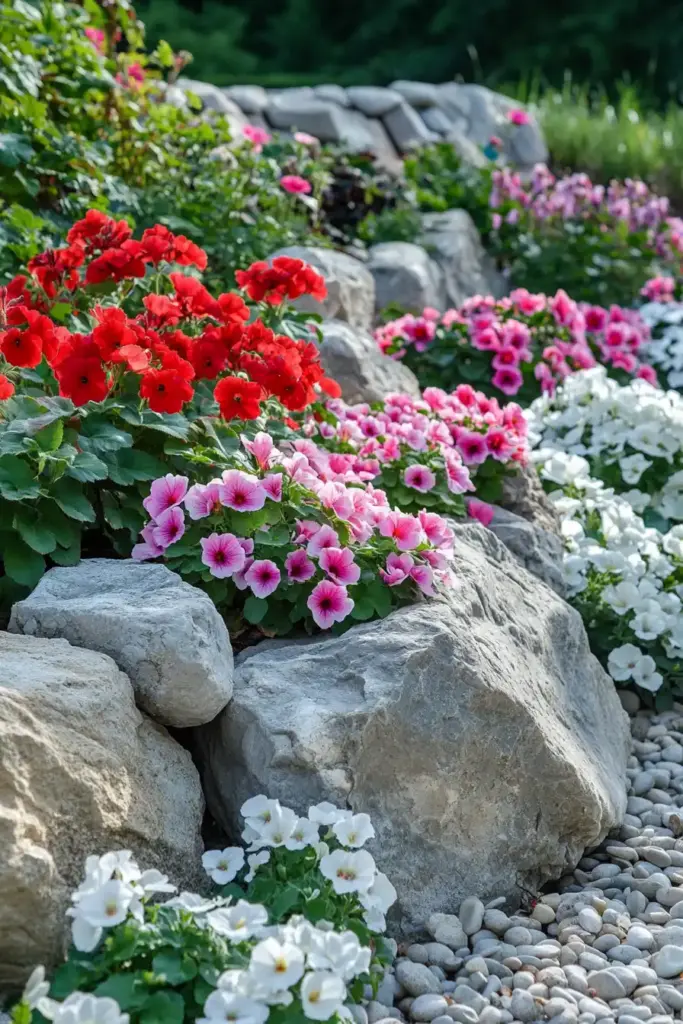
Looking to soften a rugged landscape or add color to a dry, stony area? Incorporating begonias into rock gardens is a creative twist on traditional flower bed ideas. Their bold blooms contrast beautifully with stone textures, adding visual balance and an unexpected splash of vibrance.
Why It Works:
- Color Contrast: Bright begonias pop against muted tones of stone and gravel.
- Low Profile: Compact or trailing begonias nestle naturally between rocks or along ledges.
- Thrives in Containers: Rock garden pockets or planters work well for controlling soil conditions.
Design Tips:
- Drip Irrigation: Install slow-drip systems to hydrate plants efficiently without overwatering rocky areas.
- Stone Accents: Use decorative pebbles, slate, or granite to complement your begonias and prevent soil erosion.
- Soil Selection: Choose a light, well-draining potting mix to keep roots healthy in less organic environments.
Bonus Tip:
Group begonias in odd-numbered clusters (3s or 5s) for a more natural, artistic look within the rigid layout of a rock garden.
11. Pathway Edging with Begonias: Define Walkways with Vibrant Blooms
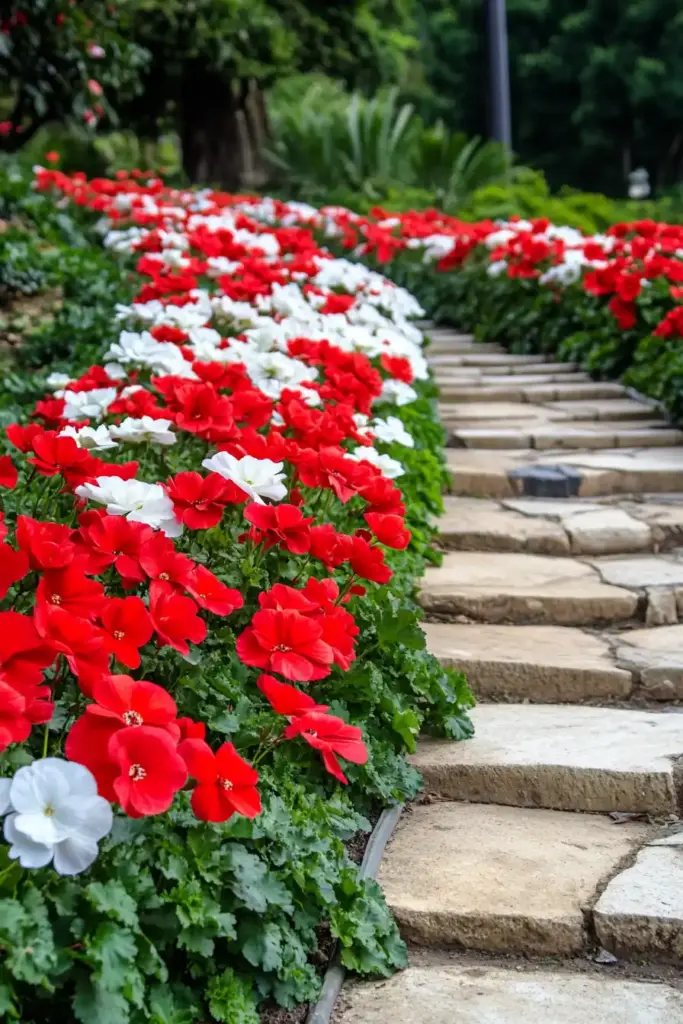
Enhance your garden paths with one of the most eye-catching flower bed ideas—lining them with colorful begonias. These compact, floriferous plants add a polished, cheerful border that guides the eye and elevates the entire landscape design.
Why It Works:
- Natural Framing: Begonias create a soft border that defines walkways without feeling rigid.
- Welcoming Aesthetic: Adds charm and warmth to garden entries or backyard strolls.
- Seasonal Flexibility: Works well with annual or perennial begonias, depending on your climate.
Design Tips:
- Pathway Pavers or Stones: Contrast hardscape materials with the soft texture of begonia foliage.
- Mulch for Uniformity: Use dark bark mulch to make begonia colors pop and retain moisture.
- Solar Garden Lights: Install low-profile lights for safe nighttime navigation and visual appeal.
Bonus Tip:
Try alternating begonia colors—such as red and white—for a candy-cane effect, or go monochromatic for a sleek, modern edge.
12. Layered Planting with Begonias: Add Depth and Dimension to Your Beds
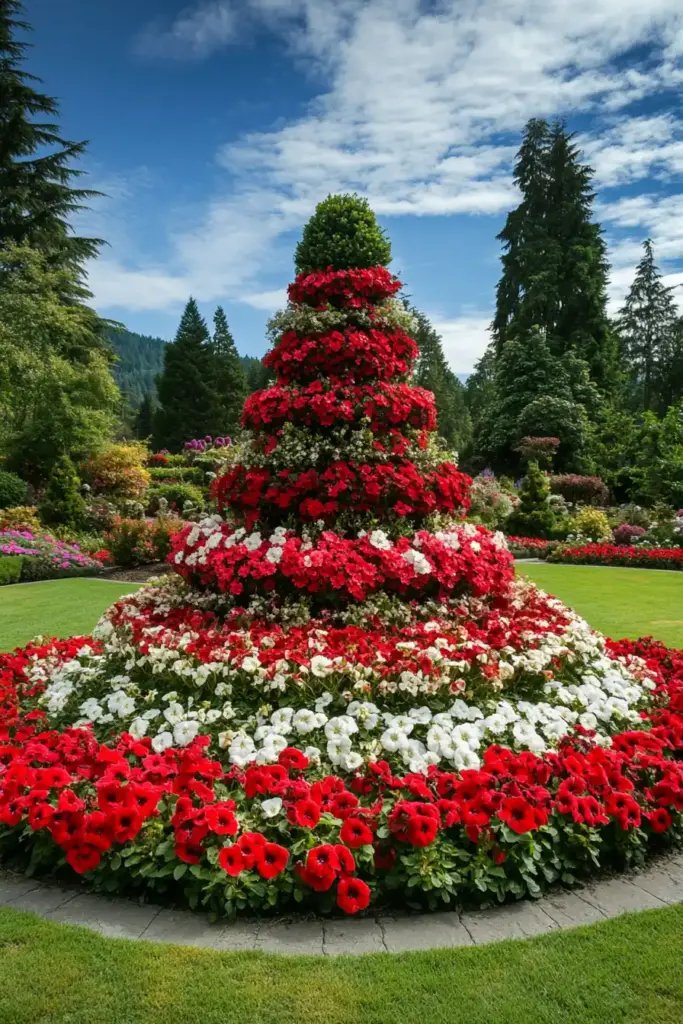
Layering plants by height, texture, and bloom time is one of the most effective flower bed ideas for achieving a full, professional-looking garden. Begonias serve as an ideal mid-layer plant, bridging the gap between taller perennials and ground covers with continuous bursts of color and tidy form.
Why It Works:
- Visual Depth: Creates a three-dimensional garden effect that feels lush and immersive.
- Seasonal Variety: Layering allows for staggered blooming, so something is always in color.
- Maximized Space: Makes the most of vertical and horizontal growing areas, especially in small beds.
Design Tips:
- Start from Back to Front: Place tall plants like ornamental grasses in the rear, begonias in the center, and low-growing flowers or ground covers in front.
- Use Plant Stands: Elevate containers or pots of begonias for added height and flexible design.
- Layered Soil Enrichment: Improve growth at every level by mixing compost into all layers of your planting bed.
Bonus Tip:
Use begonia varieties with different leaf textures or bloom sizes to create a second level of visual interest within the same layer.
13. Contrasting Textures: Elevate Your Garden’s Visual Appeal
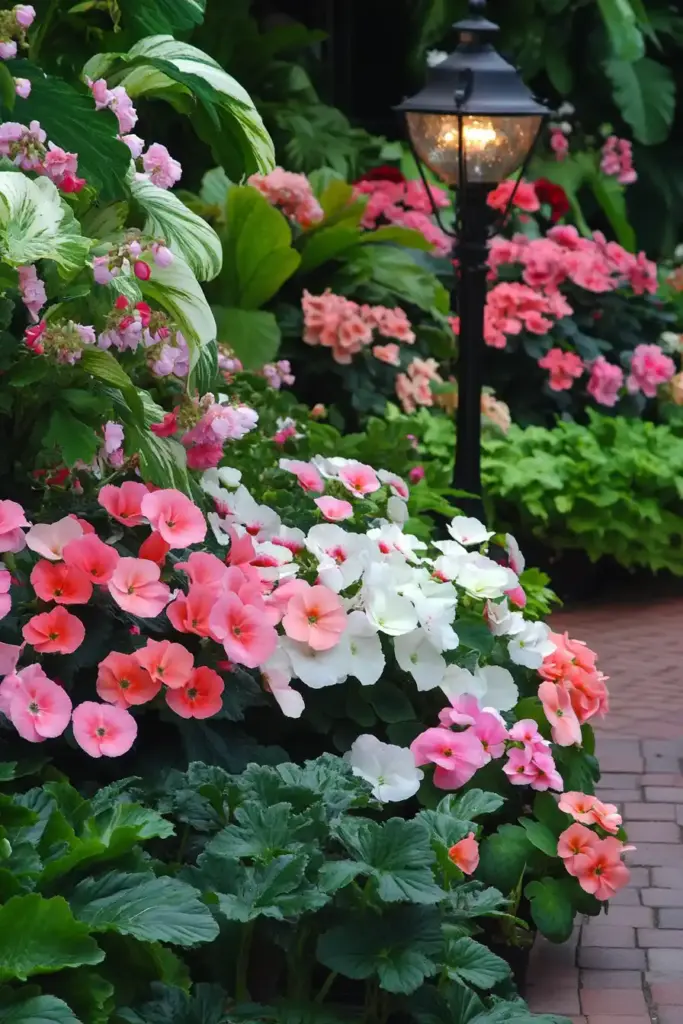
When crafting standout flower bed ideas, don’t just think in color—think in texture. Pairing begonias with plants that offer different leaf shapes and surfaces can turn an ordinary bed into a masterpiece of sensory detail. Their soft petals and structured growth provide the perfect counterpoint to both delicate and bold foliage.
Why It Works:
- Tactile Variety: Contrasts between smooth begonias and textured leaves like ferns or ornamental grasses add interest.
- Depth Through Diversity: Texture variation mimics natural plant communities and makes your garden more engaging.
- All-Season Appeal: Even after blooms fade, textured foliage holds visual weight.
Design Tips:
- Complement Soft with Sharp: Combine begonias with plants like heucheras, dusty miller, or lamb’s ear for dramatic contrast.
- Edge with Style: Use crisp borders or decorative garden edging to highlight the interplay of textures.
- Light It Right: Accent textured areas with lanterns or uplighting to emphasize form and shadow.
Bonus Tip:
Group plants in clusters by texture rather than just height or color to build a cohesive yet dynamic garden rhythm.
14. Begonias with Succulents: A Bold Blend of Color and Contrast
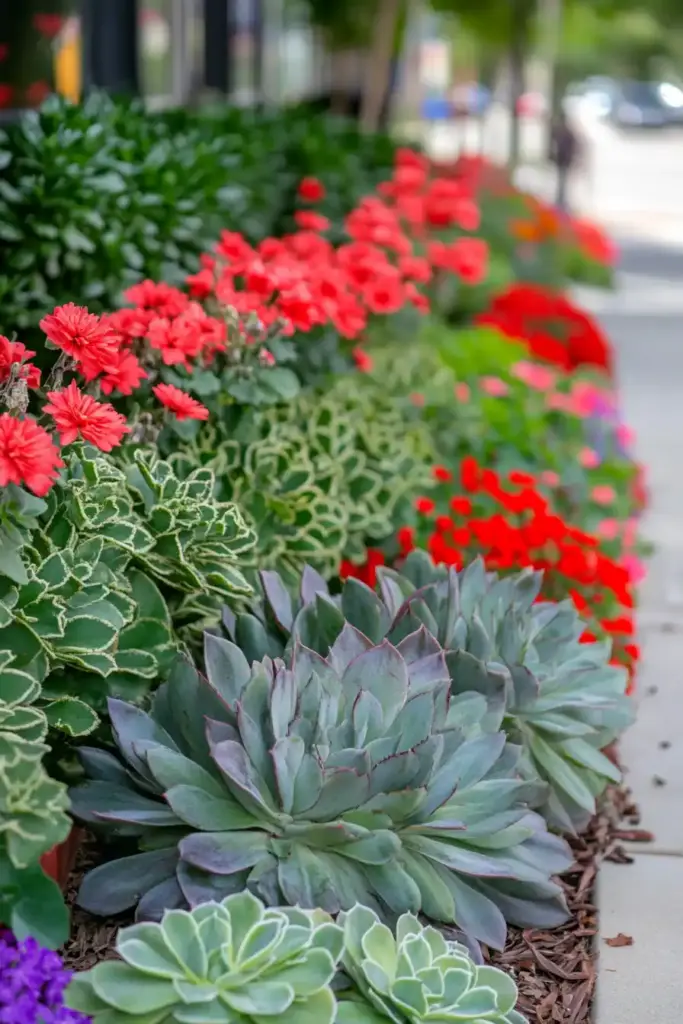
Mixing begonias with succulents is an unexpectedly beautiful combination—perfect for creative, drought-tolerant flower bed ideas. The bright, juicy blooms of begonias paired with the muted, architectural forms of succulents create a modern, artistic vibe that works well in containers or xeriscape-inspired beds.
Why It Works:
- Contrast in Color and Form: Begonias’ soft, colorful flowers complement the clean lines and cool tones of succulents.
- Water-Efficient Options: While begonias prefer moderate moisture, many can adapt to drier conditions when grown with well-draining soil.
- Great for Containers: Perfect for patios, small gardens, or areas with poor soil quality.
Design Tips:
- Soil Compatibility: Use a cactus-succulent soil blend to ensure proper drainage for both plant types.
- Planter Play: Pair in ceramic pots or concrete troughs for a sleek, contemporary look.
- Color Pairings: Match pale green succulents with hot pink or coral begonias for high contrast, or go tonal with soft peach and silver-gray mixes.
Bonus Tip:
Add a layer of decorative gravel or river stones around the base to reduce evaporation and unify the look of your mixed planting.
15. Begonia Borders for Lawns: Frame Your Yard with Floral Precision
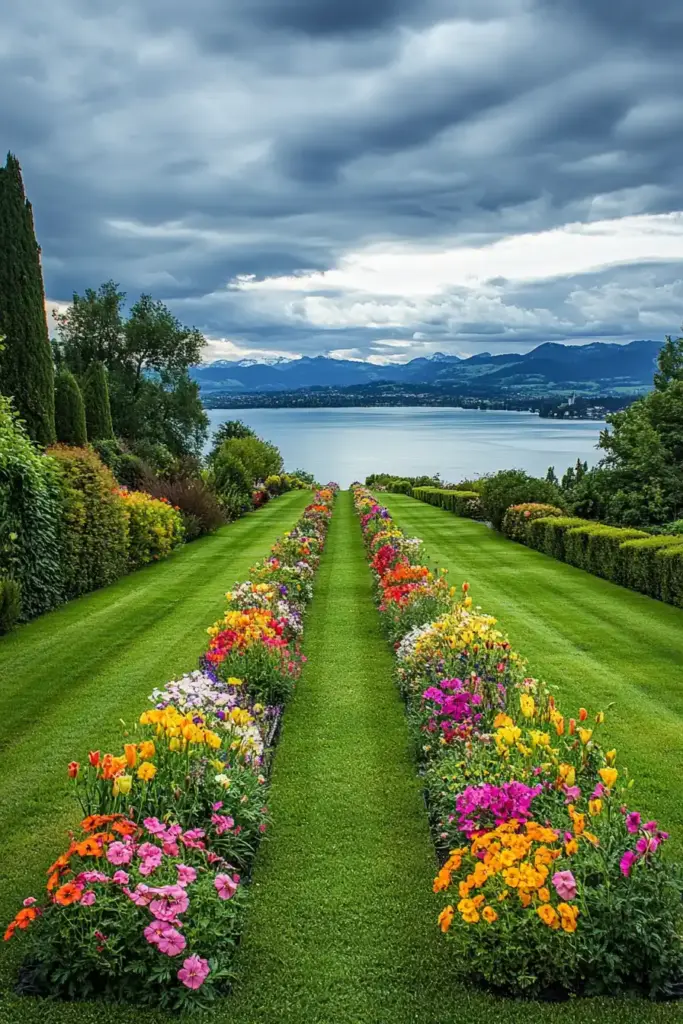
Framing your lawn with begonia borders is a timeless way to add color, structure, and curb appeal to your outdoor space. These low-maintenance flower bed ideas help define edges, soften transitions, and provide a vibrant contrast to green turf.
Why It Works:
- Crisp Definition: Neatly lined begonia borders create a clean visual break between lawn and beds.
- Season-Long Color: Begonias bloom consistently from spring to frost, keeping your lawn looking lively.
- Customizable Layout: Works with straight, curved, or geometric lawn edges.
Design Tips:
- Fence Panel Accents: Add low garden fencing to elevate the look and protect delicate blooms.
- Drip Irrigation: Install a border drip system for consistent watering without soaking the grass.
- Use Bright Bloomers: Choose high-impact begonia colors like red, yellow, or fuchsia for maximum visibility from the street.
Bonus Tip:
Try layering a row of white begonias in front of taller red ones to create a two-tone edge that gives your lawn a formal, elegant finish.
16. Begonias and Water Features: A Serene Splash of Color
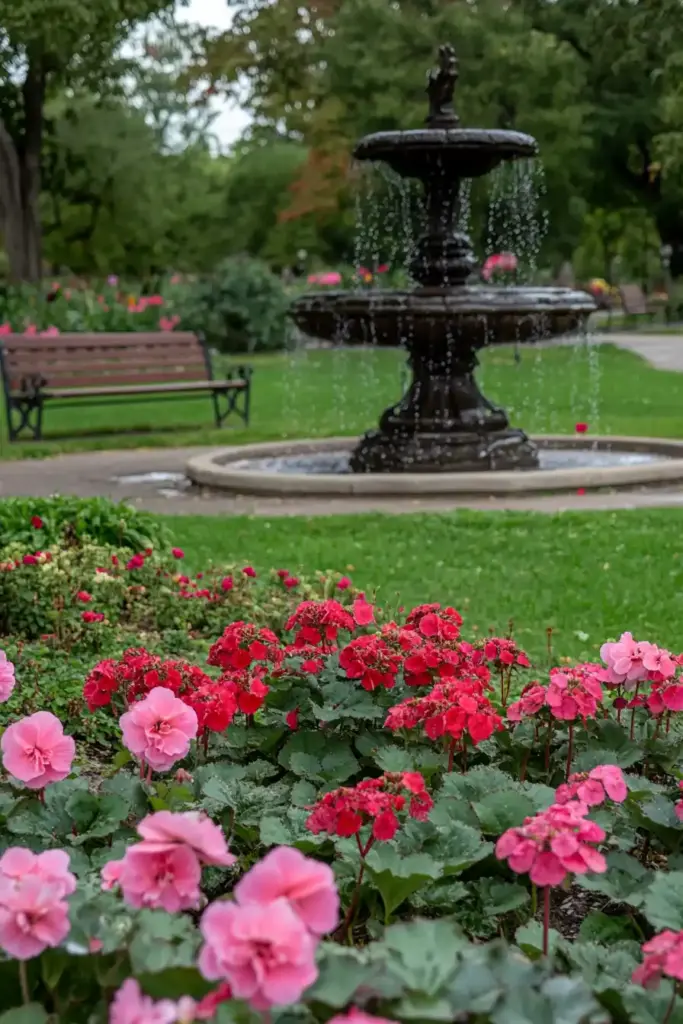
Pairing begonias with water features is one of the most tranquil and visually rich flower bed ideas you can implement. Whether nestled around a pond, a bubbling fountain, or a simple birdbath, begonias soften hard lines and reflect beautifully in the water, enhancing the peaceful vibe of your garden sanctuary.
Why It Works:
- Reflective Beauty: The vibrant blooms of begonias are doubled when mirrored in water.
- Humidity Advantage: Begonias enjoy the microclimate created by nearby water, which helps keep their foliage lush.
- Relaxing Aesthetic: The combination of colorful flowers and the sound of flowing water creates a soothing retreat.
Design Tips:
- Use Stone Planters: Anchor begonias in classic containers near fountains or pond edges for a timeless look.
- Incorporate Seating: Place a bench or Adirondack chair nearby to enjoy the view up close.
- Add Reflective Lighting: Solar or low-voltage lights can highlight blooms and shimmering water after sunset.
Bonus Tip:
Stick to cool-toned begonia varieties like pinks, whites, or soft oranges to amplify the calming ambiance of the water feature setting.
17. Begonias in Containers: Flexible Color for Every Space
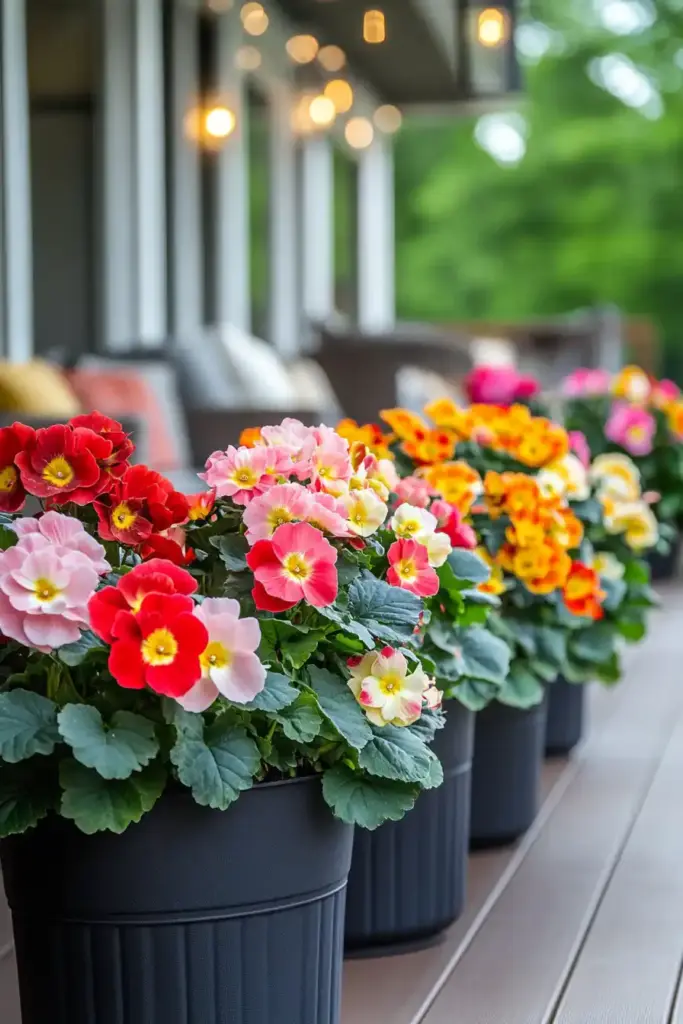
If you’re short on space or love to change your garden layout often, planting begonias in containers is one of the most versatile and stylish flower bed ideas you can try. Perfect for patios, balconies, entryways, or even as movable accent pieces within garden beds, begonias thrive in pots and offer season-long color with minimal fuss.
Why It Works:
- Movable Design: Easily rearrange containers for sunlight, seasonal displays, or special events.
- Controlled Conditions: Tailor soil, drainage, and water to your begonias’ needs.
- Perfect for Small Spaces: Containers maximize vertical and horizontal gardening options in compact areas.
Design Tips:
- Use Quality Potting Mix: Opt for a moisture-retaining, well-draining blend made specifically for container flowers.
- Mix Container Heights: Group pots of various sizes to add layers and dimension to patios or steps.
- Add Mobility: Use plant trolleys or casters for easy movement and better sun exposure.
Bonus Tip:
Choose decorative pots that complement your home’s exterior or garden theme—terracotta for a rustic feel, glazed ceramic for elegance, or metal for a modern twist.
🌼 Frequently Asked Questions (FAQ)
1. Are begonias good for flower beds?
Yes! Begonias are excellent for flower beds thanks to their vibrant colors, compact growth, and ability to thrive in both sun and shade. They’re especially effective in beds with well-draining soil and consistent moisture.
2. What type of soil do begonias prefer?
Begonias grow best in well-draining, nutrient-rich soil. A potting mix formulated for flowering plants or a blend with compost and perlite works well to promote healthy blooms and prevent root rot.
3. Can begonias be used as ground cover?
Absolutely. Many gardeners use begonias as colorful ground cover, especially in shaded or partially shaded beds. Their dense growth habit helps suppress weeds and adds vibrant texture to large areas.
4. How often should I water begonias in a flower bed?
Begonias like consistently moist soil, but not soggy. In flower beds, water them when the top inch of soil feels dry. During hot or dry periods, watering 2–3 times per week may be necessary.
5. Do begonias grow better in sun or shade?
Most begonias thrive in partial shade, though some newer varieties tolerate more sun. If you’re planting in a sunny area, choose sun-tolerant cultivars and ensure the soil stays moist.
6. What are the best companion plants for begonias?
Great companions include hostas, ferns, coleus, and impatiens—plants that enjoy similar shade and moisture conditions. For sunny beds, pair begonias with succulents or ornamental grasses for texture contrast.
7. Can I grow begonias in containers and move them around?
Yes! Begonias do wonderfully in containers, which makes them perfect for patios, balconies, or areas where sunlight changes. Use moisture-control soil and pots with drainage holes for best results.
8. Are begonias perennial or annual?
Begonias are typically grown as annuals in cooler climates but are perennial in USDA zones 10–11. In colder zones, you can dig up tuberous varieties and store them indoors over winter.
🌺 Conclusion: Bring Your Garden to Life with Begonia Flower Bed Ideas
From curved flower beds and shaded corners to rock gardens and eye-catching containers, begonias offer an impressive range of creative flower bed ideas for gardeners at any skill level. Their vivid colors, flexible growing preferences, and ability to thrive in both sun and shade make them a reliable and radiant choice for your next garden refresh.
Whether you’re upgrading a formal flower garden or adding bursts of color to a cozy patio space, these flower bed ideas with begonias can help you craft a landscape that’s both beautiful and full of personality. For even more design inspiration, explore our backyard flower garden ideas or learn how to pair begonias with other stars of the garden like hostas and hydrangeas. By mixing textures, layering heights, and using bold borders, you’ll be on your way to a begonia-filled oasis that blooms with joy and creativity.


